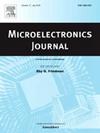A high CMRR inverter-based amplifier employing turbo-boost CMFB Loop for multi-channel bio-signal recording
IF 1.9
3区 工程技术
Q3 ENGINEERING, ELECTRICAL & ELECTRONIC
引用次数: 0
Abstract
This paper presents a high common mode rejection ratio (CMRR) capacitively coupled inverter-based amplifier (CC-INV) with a turbo-boost common-mode feedback (TB-CMFB) loop for multi-channel bio-signal recording. TB-CMFB consists of boost and turbo system-CMFB cells. The boost cell significantly attenuates the common-mode (CM) output. By further introducing the turbo cell, the CMRR of CC-INVs is much improved without relying on a large capacitance ratio in the CC-INVs or CMFB loops, maintaining high area efficiency. The proposed 4-channel CC-INVs with TB-CMFB loop is designed in a 0.18-m CMOS technology. It dissipates circa 0.9 W from a 1.8 V supply per channel, while occupying an area of 0.024 mm, and achieves a CMRR of circa 100 dB.
一种采用涡轮增压CMFB环路的高CMRR逆变器放大器,用于多通道生物信号记录
本文提出了一种高共模抑制比(CMRR)电容耦合逆变器放大器(CC-INV),具有涡轮增压共模反馈回路(TB-CMFB),用于多通道生物信号记录。TB-CMFB由增压和涡轮增压系统cmfb细胞组成。升压电池显著衰减共模(CM)输出。通过进一步引入涡轮电池,大大提高了CC-INVs的CMRR,而不依赖于CC-INVs或CMFB回路中的大电容比,保持了较高的面积效率。采用0.18 μm CMOS工艺设计了带TB-CMFB环路的4通道CC-INVs。每通道1.8 V电源的功耗约为0.9 μW,而占用面积为0.024 mm2, CMRR约为100 dB。
本文章由计算机程序翻译,如有差异,请以英文原文为准。
求助全文
约1分钟内获得全文
求助全文
来源期刊

Microelectronics Journal
工程技术-工程:电子与电气
CiteScore
4.00
自引率
27.30%
发文量
222
审稿时长
43 days
期刊介绍:
Published since 1969, the Microelectronics Journal is an international forum for the dissemination of research and applications of microelectronic systems, circuits, and emerging technologies. Papers published in the Microelectronics Journal have undergone peer review to ensure originality, relevance, and timeliness. The journal thus provides a worldwide, regular, and comprehensive update on microelectronic circuits and systems.
The Microelectronics Journal invites papers describing significant research and applications in all of the areas listed below. Comprehensive review/survey papers covering recent developments will also be considered. The Microelectronics Journal covers circuits and systems. This topic includes but is not limited to: Analog, digital, mixed, and RF circuits and related design methodologies; Logic, architectural, and system level synthesis; Testing, design for testability, built-in self-test; Area, power, and thermal analysis and design; Mixed-domain simulation and design; Embedded systems; Non-von Neumann computing and related technologies and circuits; Design and test of high complexity systems integration; SoC, NoC, SIP, and NIP design and test; 3-D integration design and analysis; Emerging device technologies and circuits, such as FinFETs, SETs, spintronics, SFQ, MTJ, etc.
Application aspects such as signal and image processing including circuits for cryptography, sensors, and actuators including sensor networks, reliability and quality issues, and economic models are also welcome.
 求助内容:
求助内容: 应助结果提醒方式:
应助结果提醒方式:


